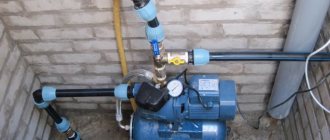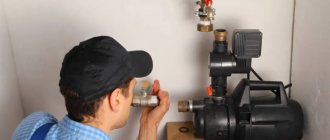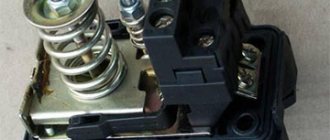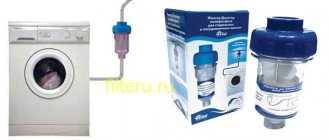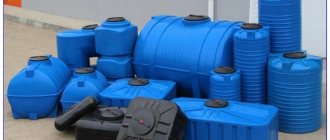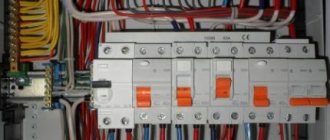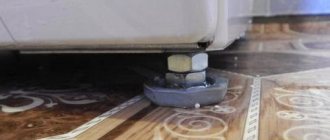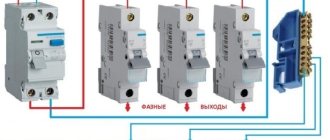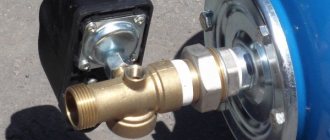In autonomous water supply and heating systems of private houses, the presence of a pumping station is mandatory.
It should be capable of automatically adjusting the parameters of the output water flow.
The requirements for reliability, operating parameters and range of operating conditions may be different.
Those who are planning to build such a system should pay attention to Jumbo pumps, in particular, those equipped with an automation unit, Jumbo 60/35 P-24 stations manufactured by Gilex.
Operating principle and design of Jumbo pumping stations
To understand the operating principle of Gilex Jumbo pumping equipment, you should understand its structure. The station has several main nodes:
- hydraulic accumulator, also known as a storage membrane tank, with a capacity of 24 liters or more;
- water pump, for more productive models with a remote ejector;
- a relay that responds to pressure changes in the tank;
- pressure gauge
The pump impeller is always made of durable polymer that is resistant to the mechanical effects of abrasives. The equipment body is made of cast iron (marked with the letter “C” in the name of the device), glass-filled polypropylene (marked “P”) or stainless steel (“N”). The hydraulic accumulator is produced only in steel version.
The pumping station operates according to this principle:
- in the initially filled tank, the pressure is at its maximum;
- as soon as the water supply tap in the house is opened, the liquid leaves the tank through the pipes and enters the plumbing points of the cottage;
- at the same moment, the pressure of the accumulator drops, which leads to the pump turning on;
- the unit pumps water into the tank until the pressure again reaches the set permissible value.
The system always has a sufficient supply of liquid for optimal pressure. The station's operating cycles are repeated.
Gilex water jet, repair of submersible pump 60/32, replacement of capacitor
The other day, an acquaintance brought a submersible pump for repair, model - Gilex 60/32, when I asked why he didn’t contact the repair service, he received the answer - he did, but the service said that the motor was faulty and for repairs they charged an amount commensurate with the cost of a new one pump
The Gilex borehole pump is quite reliable and easy to use, it does not make noise or rattle, you lower it into the well and only control its operation by the water pressure in the tap; as a rule, the warranty period for pumps made in Russia lasts in full, for similar products from the Middle Kingdom, I can’t say anything because I haven’t used it.
But as you know, nothing lasts forever under the sun, so this device has its own “weak link”, this is the starting capacitor, which is also the working capacitor SSV 60 16 uF / 450 V, this is what this handsome man looks like,
starting capacitor
Naturally, a new pump was purchased and installed, and I was “pulled up,” so to speak, as an expert - to establish the true malfunction, I, of course, agreed, and at the same time decided to collect material for this note, and so let’s move directly to the repair process.
Do-it-yourself repair, sequence
What to do if the pump hums, but does not pump water, this is a fairly frequently asked question, and today I will tell you how to solve this problem yourself. It also happens that the pump does not show any signs of “life,” but after replacing the capacitor it works properly, of course, if no other faults.
First of all, when you find that water from the well does not flow into the house, we try to apply voltage to the pump directly, bypassing the automation, for example, remove the cap from the well, disconnect the wires going to the terminal box from the pump and plug them into the socket, if the pump after that it didn’t work, which means it’s the reason and you need to take it out of the well for inspection.
Purely from experience, there are two main reasons why the pump hums but does not pump water - the starting capacitor is faulty and the pump is clogged with sand, clay or something else; unscrew the lower part of the housing to make it easier to unscrew; use a car oil filter wrench, but first clamp it the opposite side of the housing in a vice behind the water line flange.
car oil filter wrenches
Carefully remove the working rings - impellers (impellers) from the shaft, carefully, effortlessly try to turn the shaft by hand, if it rotates freely, then there are no blockages, jamming, and so on.
We supply power to the pump again, try to turn the shaft, and in this way help the pump start; if the pump starts, then the problem was in the starting capacitor, this is also valid for other models of similar pump designs.
The capacitor is located in the upper part of the pump, in order to get to it you need to very carefully, through some kind of attachment or with a non-metal hammer, lightly hit the flange, and move the motor in the pump housing.
Next, in a vertical position, shake the pump so that the engine returns to its original position, and then pull out the o-ring from the shaft side and remove the engine from the housing.
Gilex water jet pump disassembled
Then, as in the previous case, fix the motor housing in a vice by the flange and sway from side to side, open the motor housing, this is where this very capacitor is located.
In our case, the fact that the capacitor has failed is beyond doubt, since traces of mechanical destruction of the housing are visible, we replace it with a similar one and try to start the pump, everything worked fine, if in doubt, then to check, lower the pump into a container of water and make sure , so to speak clearly.
The problem is solved; we assemble the pump in the reverse order, carefully inspect the working rings - impellers for wear, often due to the high sand content in the water, which breaks the hexagonal mounting holes (on the shaft), and they become round or elliptical, in this case, pumping water through this step will not happen.
faulty capacitor in the pump motor
To illustrate the process of disassembling the pump, watch a short video; the quality of the video is poor, but I’m posting what was at the time of writing.
Model range and technical characteristics
All Jumbo pumping equipment from Gilex are labeled in such a way that the user can deduce from the name the main capabilities of the unit. For example, the name of the station NS Jumbo 70/50 N-24 will be deciphered as follows:
- NS - pumping station;
- 70 — unit productivity (l/min);
- 50 - pressure - the maximum distance the unit can transport water, calculated in meters;
- N - body material, in this case stainless steel;
- 24 - volume of the hydraulic accumulator (in liters).
There are several models of Gilex Jumbo pumping stations on the market. With the same technical characteristics, the housings can be made of different materials (steel, cast iron, polymer).
Station Gilex Jumbo 50/28
This model has the following technical characteristics:
- productivity - 50 l/min;
- head - 28 m;
- tank volume - 24 l;
- power - 500 W;
- possibility of transporting water from a depth of up to 9 m.
This station is the best option for a small summer cottage or a family of 2-3 people.
NS Jumbo 60/35
Features of this model according to the instructions:
- temperature of pumped water - +1-+50 degrees;
- productivity - 60 liters per minute;
- head - 35 m;
- permissible depth of liquid intake - 9 m;
- power - 600 W.
The approximate price of the Jumbo 60/35 model is about 8,500 rubles.
Jumbo Station 70/50
Here the unit is more powerful and productive. Its technical characteristics:
- power - 1100 W;
- productivity - 70 l/min;
- head - 50 m;
- tank volume - 24 l.
All models of Jumbo pumping stations are equipped with a soft start system and protection against dry running (combustion). Automatic control of the unit simplifies its operation.
Installation
Connection diagram for the Gilex Jumbo pumping station. (Click to enlarge) The biggest advantage is the ability to install the station on your own, without the help of specialists.
Certain installation standards have been established.
To begin with, a check valve is attached to the connection point of the water pipe; it was written about earlier; when turned on, it allows water to flow into the pipes.
If these simple rules are followed, the pumping station will serve for a long period of time in a private home or country house. In online stores you can read reviews about different models and decide for yourself what is more important, then make a choice and place an order. If the station breaks down, you can purchase the necessary spare parts and make repairs.
Watch the video in which a specialist describes in detail the design and operating features of the 60/35P-24 pumping station:
Our compatriots were once again convinced that Russian-made products are no worse than foreign ones. Gilex Jumbo pumping stations are distinguished by good technical characteristics and show their best performance in work on a dacha/suburban area.
How to choose a station for a country house
Gilex Jumbo 50/28 in a cast iron body
In order for pumping equipment to work as efficiently as possible (do not overuse electricity and supply the optimal volume of water), when choosing it, you need to rely on the following criteria:
- Performance. Determined by the number of plumbing points in the house and the number of people living in it. In this case, the productivity of the unit should not be greater than the flow rate of the water intake source. Otherwise, the station will shut down due to the danger of dry running.
- Storage tank volume. For a family of two people, it is enough to take a hydraulic accumulator with a capacity of 24 liters. For 3-5 people living in a house, a volume of 50 liters is already needed, and so on.
- Station pressure. It is calculated simply - the vertical distance from the unit to the highest plumbing point + 1/10 of the total horizontal length of the pipeline + tap pressure (from 4 to 10 m).
- Case material. Here you need to rely on the future operating conditions of the equipment. Steel and cast iron are suitable for more “field” ones. The polymer will be cheaper, but it is better to use it in a warm room.
- Equipment power. It must correspond to the family’s ability to pay for utilities with optimal technical characteristics of the station.
If water will be taken from a depth of more than 10 m, it is worth taking equipment with a remote ejector.
Operating principle of the product
When the unit is connected to a power source with a mains voltage of 50 Hz, the armature is attracted to the core. Every half cycle it is thrown back by the shock absorber. Thus, during 1 period of the current wave, the attraction of the armature occurs twice. Therefore, in 1 second it is attracted a hundred times. Frequent vibration of the piston located on the rod with the armature is also observed.
Brook pump without casing
Thanks to the volume limited by the valve and piston, a hydraulic chamber is formed. The actions in it are springy due to the elasticity of the pumped medium containing dissolved air and the vibrations of the piston. While the water is pushed into the pressure pipe, and the spring expands and contracts, the valve allows the liquid to enter and exit through the suction holes.
The Rucheek pump comes complete with a nylon cable used for its fastening and installation. The cable protects the consumer from electric shock in the event of an insulation breakdown, since it does not conduct current.
Features of operation and maintenance
Installation diagram
Jumbo pumping stations are sold ready for installation. The main rule during installation is not to run the equipment dry. It is imperative to add water to the system.
Before continuous operation, the operating pressure should be adjusted using a pressure gauge.
Once a year it is advisable to lubricate the working components of the station. If operation in winter is not intended, the equipment is dismantled and put away until the next season.
It is advisable to check the equipment annually: monitor the tightness of the pipes, monitor the water level at the source.
To avoid vibration of the equipment during operation, it is better to place the unit on a rubberized base. It will also dampen the noise of operating equipment somewhat.
In case of any breakdowns, you should contact the service center. Although Jumbo stations from Gilex, according to reviews, break down extremely rarely.
A few words about adjusting the pressure switch
Pressure switch
is a device that automates a pumping station. The relay regulates the pressure in the water supply network, which is maintained by a hydraulic accumulator. Therefore, the pressure switch and accumulator always work in pairs.
The pressure switch unit reacts when the tank is full or empty. The manufacturer makes the default setting (minimum pressure 1.5 atmospheres and maximum pressure 2.5 atmospheres).
After connecting the relay to the pump, the relay is configured for a specific object (set by the water pressure in the system by the technologists).
Setting up a relay for an individual project:
- The relay housing is opened, where the relay control units are located
. The minimum pressure is adjusted by the tension of the large spring, and the maximum by the tension of the small spring. - The adjustment of the “minimum” pressure begins on an empty storage tank.
To do this, just turn off the pump and open the water tap. Then loosen the large spring. Then turn on the pump and gradually tighten the spring. As soon as the pump begins to supply water, the large spring is no longer touched; the minimum pressure is equal to the pressure of the air mass. - Adjusting the differential pressure is even easier.
The pump is turned off and the pressure value at the relay is measured. If the result is not satisfactory, the large or small spring is adjusted again. After which the pump is turned on again and the maximum pressure is measured.
Advantages and disadvantages
Users note the following positive aspects of Jumbo stations:
- smooth start;
- no water hammer in the system when turned on;
- constant water pressure in a country house;
- compactness of the unit;
- ease of installation and connection;
- protection against voltage surges, dry running.
The only disadvantage mentioned is the increased noise level of the station. But this problem can be solved if you install the equipment in a soundproofed room.
Customer Reviews
According to reviews, the Jumbo pumping station is ideal for installing an autonomous water supply system in a country house or country house.
Nikolai, 38 years old: I bought the Jumbo 70/50 station three years ago, when I finished building the house. For a family of four, I took equipment with a 50-liter tank. From the house to the well there are 20 meters plus a water surface of 6 meters. Additionally, I have a plot of 5 acres. All this is supplied with water by the hard-working Jumbo. In summer it pumps continuously for watering for 3-4 hours. It still works fine. The station was installed in the basement. It's true that it's noisy, but I put a thick rubber mat on it. They are thinking about isolating the basement from the house to prevent noise.
Pavel, 33 years old: At my dacha there is a Jumbo 60/35 in a cast iron body. Initially I bought it for watering the garden. Now he has built a three-room house on the site. For my wife and I, such a unit (shower, toilet, kitchen sink) is enough. The noise of the station was neutralized by a special insulated caisson. For two years there are no complaints about the unit.
Yura, 29 years old: I bought a Jumbo 50/28 station in a steel case for watering my garden. To prevent the unit from jumping during operation, it was additionally fixed (there are special fastening legs). The equipment works properly and supplies water with good pressure. In two hours of continuous work we water 6 acres of garden. Normal, I think, for a Russian apparatus.
